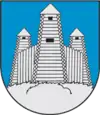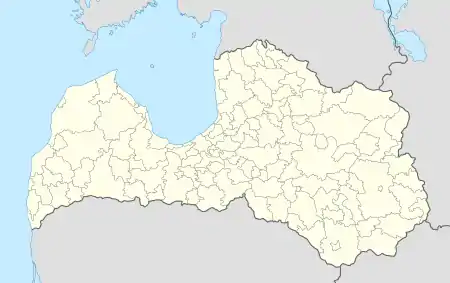Saldus
Saldus (![]() pronunciation ; German: Frauenburg) is a Latvian town located in Courland (Latvian: Kurzeme) and is the main town, and the central location in Saldus Municipality. The name Saldus has been noted in historical sources as far back as the mid-13th century, but the founding year is considered to be 1856, and it gained town rights in 1917.[1]
pronunciation ; German: Frauenburg) is a Latvian town located in Courland (Latvian: Kurzeme) and is the main town, and the central location in Saldus Municipality. The name Saldus has been noted in historical sources as far back as the mid-13th century, but the founding year is considered to be 1856, and it gained town rights in 1917.[1]
Saldus, Latvia | |
|---|---|
Town | |
| Saldus | |
 | |
 Flag  Coat of arms | |
| Nickname(s): Medus Piliens Kurzemē 'A drop of honey in Courland' | |
 Saldus, Latvia Location in Latvia | |
| Coordinates: 56°40′N 22°30′E | |
| Country | |
| Municipality | Saldus Municipality |
| Town rights | 1917 |
| Government | |
| • Mayor | Māris Zusts |
| Area | |
| • Total | 10.1 km2 (3.9 sq mi) |
| Population (2019) | |
| • Total | 9,937 |
| • Density | 983.86/km2 (2,548.2/sq mi) |
| Time zone | UTC+2 (EET) |
| • Summer (DST) | UTC+3 (EEST) |
| Postal code | LV-3801 |
| Calling code | +371 638 |
| Number of city council members | 11 |
| Website | https://www.saldus.lv/ |
The city is almost precisely in between Riga and Liepāja (slightly closer to ‘Liepāja’ (100 km), than Riga (119 km). River Ciecere flows through Saldus, and it is a tributary to one of Latvia’s biggest rivers Venta.[1]
The city is often referred to as "the Bowl of Courland". This is because of a famous quote by Māris Čaklais: "A drop of honey in the bowl of Courland". The reasoning behind the quote is the fact that from a high point, the city looks like a crater.
As of January 2019, Saldus is the 17th-largest city in Latvia according to population data. In 2019 the town had a population of 9937.
Along the city runs the Riga–Liepāja railway, with the train station located outside the city limits.
History
Early history
According to archeological research, the whole territory that is now Saldus was inhabited by the Baltic tribe Couronians in the 20th century BC. The centre of defence at the time, Saldus Castle, was located by Lake Saldus until the 13th century,
1856 is considered the year Saldus was founded, when the Board of Domens decided to establish a trade center. Although there was an active economy by the end of the 19th century, and Saldus was the cultural center of the region, it was not officially recognized as a town until 1917.
One of the oldest buildings in the town is Saldus St.John's church. Documents from 1461 mention a wooden church. It has been reconstructed several times. The tower, bombed in 1944, was rebuilt in 1981–82.
As of 2019 the town had a population of 9937.
Demographics
The population of Saldus has been decreasing since the first recorded census. It declined more rapidly when moving to United Kingdom became a valid choice for the people of Latvia.[2]
| Year | Pop. | ±% |
|---|---|---|
| 1989 | 12,330 | — |
| 1990 | 12,113 | −1.8% |
| 1991 | 12,469 | +2.9% |
| 1992 | 12,452 | −0.1% |
| 1993 | 12,452 | +0.0% |
| 1994 | 12,472 | +0.2% |
| 1995 | 12,540 | +0.5% |
| 1996 | 12,597 | +0.5% |
| 1997 | 12,576 | −0.2% |
| 1998 | 12,658 | +0.7% |
| 1999 | 12,660 | +0.0% |
| 2000 | 12,557 | −0.8% |
| 2001 | 12,483 | −0.6% |
| 2002 | 12,413 | −0.6% |
| 2003 | 12,365 | −0.4% |
| 2004 | 12,289 | −0.6% |
| 2005 | 12,234 | −0.4% |
| 2006 | 12,138 | −0.8% |
| 2007 | 12,016 | −1.0% |
| 2008 | 11,987 | −0.2% |
| 2009 | 11,919 | −0.6% |
| 2010 | 11,735 | −1.5% |
| 2011 | 11,413 | −2.7% |
| 2012 | 11,217 | −1.7% |
| 2013 | 11,022 | −1.7% |
| 2014 | 10,895 | −1.2% |
| 2015 | 10,771 | −1.1% |
| 2016 | 10,627 | −1.3% |
| 2017 | 10,311 | −3.0% |
| 2018 | 10,053 | −2.5% |
| 2019 (est.) | 9,937 | −1.2% |
Economy
Saldus has developed itself as an important cultural, educational, business and trade center. There are about 500 approved companies operating in Saldus, with main branches in building construction, wood processing, and food processing.
These days Saldus also boasts a very active cultural life, featuring local musicians, poets, painters, and artists.
Hymn
The official hymn of the city, written by Ēriks Ķiģelis and Māris Čaklais, is ‘’Saldus saule’’ (English: Saldus Sun).
On November 18, 2018, 32 years since its release in 1986, the song was finally publicly acknowledged as the official hymn.
| Lyrics |
| Rudenī viņa kā rupjmaize Siltiem gabaliem laužama, Ziemā kabatā sildītu Es viņu kā burkānu graužu. Vasarā bērniem galviņas Sauli, ko vienreiz var iegūt, Pāri Kalnsētas kokiem austoša, 2x |
Education
The city boasts an active cultural and social life. In the center of it has always been Education. Home to schools of the future and the past. All educational institutions are coed.
Since 1946 Saldus has been home to the Saldus School of Music. In 1984 Saldus Art School was founded.
On March 22, 2013 the Saldus Art School moved to the newly built building.
Up until 2016, there were 2 high schools in the city: Saldus Gymnasium (ex 1.st High School) and Saldus Secondary High School. Saldus Gymnasium was terminated and never started the school year in 2016.[3] Saldus Secondary High School was re-named Saldus High School.
Educational institutions
- 6 Pre-school educational institutions
- 3 Primary Schools
- Saldus High School
- Vocational High School
- Saldus Art and Music School
Culture and conteporary life
Saldus Saule festival
Yearly Rock festival 'Saldus Saule' makes Saldus a well known city in and around Latvia.[4] The first "Saldus saule" took place in 1987. But the idea and concept were conceived earlier.[4]
October 3, 1985, saw the death of a beloved musician - Ēriks Ķiģelis. The twenty-somethings of that time wanted to keep his memory alive and so the festival was born. Due to the USSR regime, the festival could not be named after Ēriks Ķiģelis.
The first festival was first organized by famous music sociologist Juris Vilcāns and Ēriks Niedra.
Geography
Saldus is geographically located in the ‘Austrumkursas’ Highlands. It is the biggest city in the Highlands. The city was built on both shores of the river ‘Ciecere’ and on the east side of the city lies ‘Saldus lake’. The city is considered to be one of the greenest cities in Latvia, due to being characterized with parks, squares and bountiful greenery. [5]
There are many tiny rivers, that flowing through Saldus, but only one important one. Interestingly other rivers are also named.
River Ciecere
River Ciecere is a 51 km long right-bank tributary to river Venta. The river itself has 52 tributaries. It flows out from Lake Ciecere and for 6 km flows through Saldus, creating a very rich green-zone in the city center. The river has 14 crossing bridges. In Saldus there are a few artificial waterfalls. There are nature-walks along the river bank. In the 17th century, the river was navigable by ship and boat.
Saldus Lake
The lake lies north-east of the city, on the edge of the city. The lake’s north-west and south-east shores are incredibly steep. The lake has an estuary – Vēršāda (a tributary from river, and a tributary – Kaļķupīte. The deepest point is 5 m. On the south-west shore there is an artificial beach.
Notable people
- Johann von Besser (1654–1729) – German writer
- Jānis Blūms (born 1982) – basketball player
- Ursula Donath (born 1931) – German athlete
- Janis Rozentāls (1866–1917) – painter
- Lea Davidova-Medene (1921–1986) – sculptor
- Māris Čaklais (1940–2003) – poet
- Ēriks Ķiģelis (1955–1985) – musician
- Dons (born 1984) – singer
- Ieva Laguna (born 1990) – top model
- Uģis Žaļims (born 1986) – bobsledder
- Oskars Kalpaks (6 January 1882 – 6 March 1919) - Battalion Commander[6]
Gallery
 Monument of Janis Rozentāls
Monument of Janis Rozentāls Saldus Lake
Saldus Lake Lutheran church in Saldus
Lutheran church in Saldus Saldus Sign
Saldus Sign The Old City Gymnasium
The Old City Gymnasium
References
- Saldus; Kurzemes mazpilsēta gadu ritumā; 1253-1856-1996. Saldus: Saldus Pilsētas Dome. 1996. pp. 7, 8, 9. ISBN 9984-581-00-4.
- "Iedzīvotāju skaits un tā izmaiņas statistiskajos reģionos, republikas pilsētās, novadu pilsētās un novados". Centrālā statistikas pārvalde. Centrālā statistikas pārvalde. May 28, 2019. Retrieved May 31, 2019.
- "Saldus pilsētā likvidēs abas vidusskolas un veidos vienu mācību iestādi". www.lsm.lv (in Latvian). Retrieved 2019-05-03.
- "Par Festivālu". Saldus Saule. SIA Festivāls Saldus Saule. Retrieved May 31, 2019.
- Valdemārs, Ancītis (1992). Cieceres, Ventas un Vadakstes krastos. Saldus: Saldus tipogrāfija. pp. 13, 14, 15, 16, 17, 57, 58, 108, 109.
- Mugrēvičš, Ēvalds (1989). "Leģenda un vēsturiskā īstenība: Pulkveža Oskara Kalpaka (1882.-1919.) dzīves ceļš un cīņu gaitas". Dzimtenes Balss: Nr.19, page 6., Nr.20, page 6., Nr.21, page 6.
- Saldus; Kurzemes mazpilsēta gadu ritumā; 1254-1856-1996. Saldus: Saldus Pilsētas Dome. 1996. p. 140. ISBN 9984-581-00-4.
- "Sadraudzības pašvaldības". Saldus. 2017. Retrieved 3 May 2019.